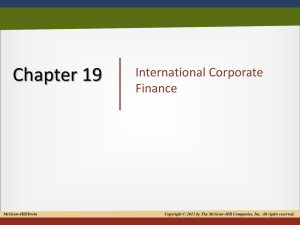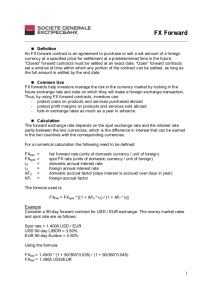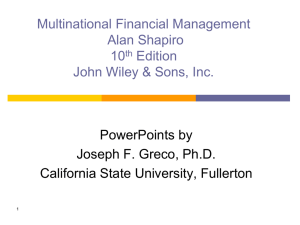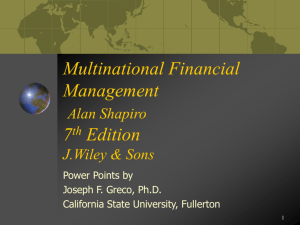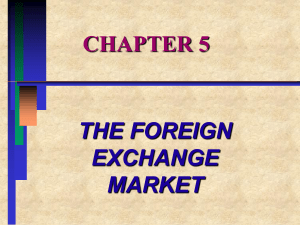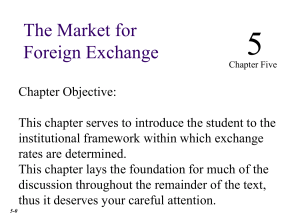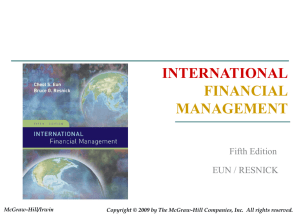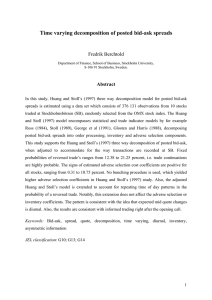CH16-1
advertisement
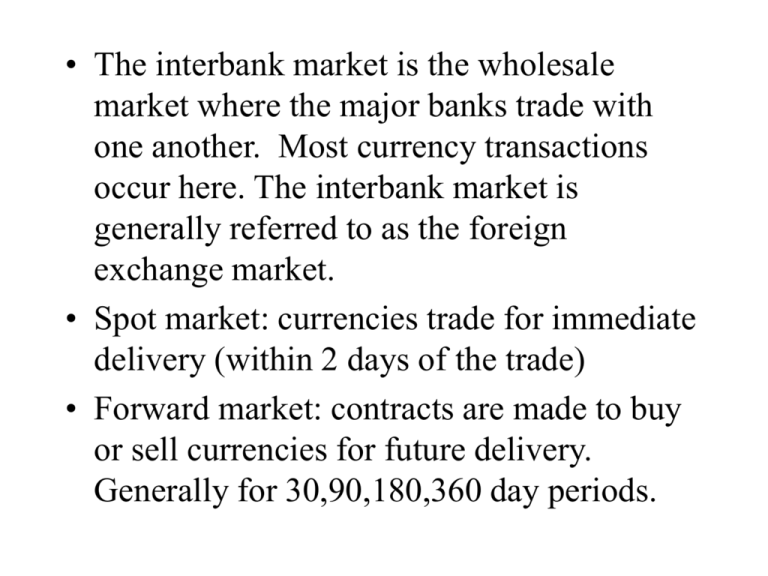
• The interbank market is the wholesale market where the major banks trade with one another. Most currency transactions occur here. The interbank market is generally referred to as the foreign exchange market. • Spot market: currencies trade for immediate delivery (within 2 days of the trade) • Forward market: contracts are made to buy or sell currencies for future delivery. Generally for 30,90,180,360 day periods. • The participants in the foreign exchange market are the large commercial banks, foreign exchange brokers, the major multinational corporate customers, and central banks. • The foreign exchange market is the largest financial market in the world. In 1995 daily volume was $1.2 trillion. • Spot quotations 1. Direct quotes: DC/FC e.g. $/DM 2. Indirect quotes: FC/DC e.g. DM/$ • Bid-ask spread Banks generally do not charge commissions on foreign currency transactions. Instead, they make their profit off the bid-ask spread. The bid price- the price the bank will pay for FC The ask price - the price the bank will sell FC • The bid-ask spread is a function of the breadth (number of market participants) and depth (volume of purchases) of the market for the currency as well as the currency’s price volatility. • % spread = [(ask price-bid price)/ask price]*100 • The more widely the currency is traded, the narrower the spread • The forward bid-ask spreads are wider than current spot spreads • Financial press quotes are for interbank market transactions. Local nonbank quotes will be less favorable. • Bid-ask spreads will also differ based on the individual bank’s currency needs. • Quotes are size related. The smaller the transaction, the larger the spread • Cross rates The cross rate is the rate of exchange between two non-U.S. currencies. Suppose 1.7799 SF/$ and 2.2529 DM/$. What is SF/$? 0.79005 SF/DM • The forward market Forward contracts between a bank and a customer call for delivery of a specified amount of a currency quoted against the dollar on a specific future date. The exchange rate is fixed at the time the contract is entered into. • Let’s say a U.S. bank must pay a Swiss bank SF 100M in 90 days. The U.S. bank has dollars now but needs future Swiss francs, so the U.S. bank is in effect short the Swiss franc. In order to offset this short position risk, the U.S. bank will buy (go long) the Swiss franc in the forward market. • E.g.) A U.S bank is obliged to make a future payment of SF 100,000 in 60 days. To manage its exchange rate risk the firm contracts to buy the SF 60 days in the future at 1.7530 SF/$. The current exchange rate is 1.7799 SF/$. • At the time of payment the exchange rate fell to 1.6556 SF/$, the firm would have lost (100,000/1.7530 -100,000/1.6556)= -$3,356.00 on its commitment on the spot market • But, fortunately, the U.S. bank gets to buy the SF at 1.7530 SF/$ rather than at the 1.6556 rate in effect at the time the commitment must be met. The actual loss on the commitment is exactly offset by the gain on the forward contract • If at the time of payment the exchange rate had risen to 1.8250 SF/$, the bank would have gained (100,000/1.7530 - 100,000/1.8250) = +$2,250.55 by being able to pay off its commitment with cheap SF. But unfortunately the bank must buy the SF at 1.7530 SF/$ on the forward market. Thus, the gain on the commitment is exactly offset by the loss on the forward contract. • The interest rate parity (IRP) Interest rate parity shows that there is a relationship between the spot and forward exchange rates and the domestic and foreign interest rate in the countries represented by the exchange rates. • Forward (DC/FC) = Spot (DC/FC) [(1+Rdomestic)/1+Rforeign)] • Suppose that you can invest in DM at r = 5.127% or you can invest in SF at r = 5.5%. You are a resident of Germany and the current spot rate is 0.79005 DM/SF. Calculate the one-year forward rate expressed in DM/SF. Forward rate (DM/SF) =0.790059 (1.05127/1.055) = 0.78726 DM/SF





